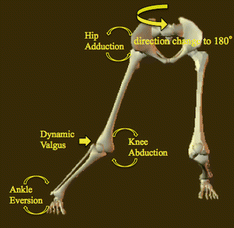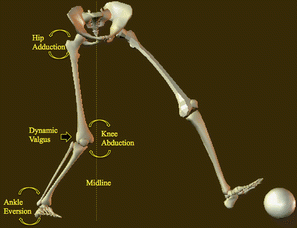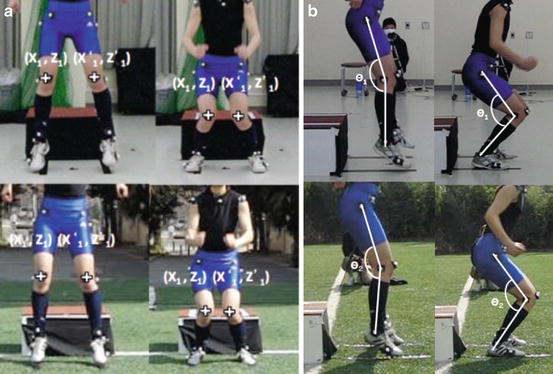Fig. 12.1
Dynamic valgus during landing
12.2.2 Cutting Maneuver
ACL injury risk was found to be associated with knee abduction angle and knee abduction moment in a series of prospective studies which analyzed landing (Hewett et al. 2005; Myer et al. 2010, 2011a, b). Therefore, knee abduction angle and knee abduction moment during the cutting maneuver may also be risk factors for ACL injury. In fact, knee abduction angle and knee abduction moment during the cutting maneuver are reported to be greater in women than in men (Malinzak et al. 2001; McLean et al. 2004; Sigward and Powers 2006). Malinzak et al. (2001) reported that peak knee flexion angle is smaller in women than in men. Mclean et al. (2004) analyzed the relationship between hip motion and knee joint valgus moment in view of their impact on the knee joint. A positive correlation was found between hip internal rotation and the peak knee abduction moment. On the other hand, no gender difference was observed in the peak knee flexion angle. Also Kristianslund et al. (2014) reported on approach speed and knee abduction angle, and noted that cutting angle affected knee abduction moment during the cutting maneuver.
The above circumstances indicate the possibility that knee abduction angle and knee abduction moment during the cutting maneuver as well as during landing are risk factors for ACL injury. In soccer, ACL injury frequently occurs during the cutting maneuver (Agel et al. 2005; Hewett et al. 2005) (Fig. 12.2) and when stealing the ball (Fig. 12.3). Therefore, a motion analysis of the cutting maneuver is useful in understanding the mechanism of ACL injury in soccer players.



Fig. 12.2
Dynamic valgus during a direction change of 180°

Fig. 12.3
Dynamic valgus when stealing the ball
12.3 ACL Injury Prevention Program
In the second section our aim is to summarize the effect of the ACL injury prevention program on ACL incidence rate as well as the effect of the program on body kinematics during the jump-landing and cutting maneuver.
12.3.1 Effects of the Prevention Program on ACL Injury Incidence Rate
Hewett et al. (1999) report that the incidence rate of knee injury in female athletes decreased after a plyometric training program of 6 weeks. Additionally, Petersen et al. (2005) report that the incidence rate of knee injury decreased in female handball players after a training program that combined balance and jump activities. Mandelbaum et al. (2005) introduced the Prevent Injury, Enhance Performance (PEP) program as an ACL injury prevention program for female football players. An evaluation of the results obtained by PEP program intervention indicated a significantly lower injury incidence rate in the intervention group as compared to the non-intervention group. Another preventive program was introduced by the Federation of International Football Association (FIFA) and was entitled 「The 11+」 program for preventing injuries in soccer. An evaluation of 「The 11+」 program intervention also demonstrated a significantly lower injury incidence rate in the intervention group as compared to the non-intervention group (van Beijsterveldt et al. 2012). The above information as well as other studies (Petersen et al. 2005; Mandelbaum et al. 2005; Myklebust et al. 2003) have documented the effectiveness of ACL injury prevention programs in decreasing the ACL injury incidence rate.
12.3.2 Effects of ACL Injury Prevention Programs on ACL Injury Risk Factors
Jump-Landing
Most of the programs for ACL injury prevention in the current literature function to alter lower extremity movement patterns.
Biomechanical analysis of landing characteristics have been used to verify the effect of intervention on ACL injury in cross-sectional studies to date. Pollard et al. (2006) conducted a jump program with a focus jump and agility training for female soccer players and investigated changes in hip and knee joint angles during drop landing. As a result, although no change was observed in knee flexion and abduction angles, female players did demonstrate a lesser hip internal rotation and greater hip abduction. Hewett et al. (1999) reported that knee abduction moment and ground reaction force at the time of landing was reduced by jump training. Furthermore, Myer et al. (2011b) investigated the effect of balance training and plyometric jump training on a non-risk group and risk group for the knee abduction moment. As a result, the knee abduction moment was decreased in the risk group. Additionally, Lephart et al. (2005) reported that jump training produced an increase in hip and knee angles although no change was observed in knee abduction and hip adduction angles.
The overall results of these reports indicate that ACL injury prevention training, at least with respect to biomechanical factors, is effective to some extent. However, such evidence is not conclusive. These prevention programs are similar in that they involve plyometrics, balance, and agility training; however, the details, duration, and the training maneuvers vary depending on the program. Furthermore, the assessment environment (laboratory) is quite different from the actual training environment. Thus, although motion analysis has been carried out in the laboratory environment, it has not been conducted in an actual training environment. To remove this knowledge gap, we conducted a pilot study to clarify body kinematics during the drop vertical jump test. We assessed differences between the laboratory environment and an artificial turf for female collegiate soccer players (Fig. 12.4). On artificial turf displacement of the knee flexion angle was significantly smaller than that of the corresponding laboratory measurement (p <0.05). A statistically significant difference was not observed in knee valgus motion. Thus, laboratory measurements are likely to underestimate values of the actual training environment.


Fig. 12.4
Differences between the laboratory environment and an artificial turf (a) frontal plane (b) saggital plane
Cutting Maneuver
In addition to the longitudinal studies described earlier, a recent cross-sectional study was performed on the cutting maneuver. Celebrini et al. (2014) conducted prevention programs using videotapes of the jump-landing technique. The groups given feedback showed increased knee angular displacement flexion angles and decreased peak vertical ground reaction forces. This shows that sports techniques with complicated maneuvers can profit from feedback training. However little scientific research on cutting has been conducted to carefully document the effectiveness of prevention programs. Longitudinal studies are needed to evaluate the effect of intervention programs on cutting as well as landing. Additionally, because ACL injuries in soccer frequently occur during the cutting maneuver, it is important to conduct research on this maneuver to elucidate the mechanism of injury occurrence.
12.3.3 Components of ACL Injury Prevention Programs
Plyometric Training
Several studies have investigated the effects of plyometric training on lower extremity motion patterns.
Lephart et al. (2005) reported that hip and knee angles increased following jump training. However, no change was observed in knee abduction and hip adduction angles. Irmischer et al. (2004) reported that after training there was a decrease in ground reaction force during landing. Additionally, Soderman et al. (2000) reported that jump training decreased knee valgus motion.
Balance Training
Caraffa et al. (1996) found that balance training alone was effective, whereas Soderman et al. (2000) did not find it to be effective. Including multiple elements in the balance training program has been shown to have a preventative effect (Myklebust et al. 2003; Olsen et al. 2005). A study conducted by Pfeiffer et al. (2006) did not include balance training failed to show a preventative effect. Therefore, unless a training program is comprehensive and contains a number of effective elements, it may not produce a measurable preventative effect.
Feedback Training
Feedback training is a commonly used method for teaching and learning physical techniques. It can be used as an intervention technique to change motor control strategies such as faulty movement biomechanics that are associated with ACL injury.
Prapavessis and McNair (1999) studied the effects of augmented feedback on lower extremity kinematics and kinetics in drop landing tasks. The augmented feedback group significantly decreased their vertical ground reaction force after training. Onate et al. (2005) investigated the effect of different types of video feedback on landing technique. The ‘expert instruction’ group viewed a trained expert conducting jump-landing tasks. The ‘self-feedback’ group viewed their own jump landing tasks. The combined ‘instruction and feedback’ group viewed both the expert’s and their own jump landing tasks. A group which received neither instruction nor self-feedback served as the control group. The self-feedback and combined feedback groups had more knee flexion and less peak ground reaction force than did the ‘expert instruction’ or control groups.
From the above, it can be seen that sports techniques with complicated maneuvers require feedback training. Simply viewing good technique is not adequate.
Strength Training
Cochrane et al. (2010) reported that strength training alone might not be sufficient to positively alter biomechanical risk factors associated with ACL injury. However, strength training could improve movement patterns if it was combined with feedback training. Cochrane et al. (2010) investigated knee alignment during movement and divided the subjects into a balance training group and a weight training group. The balance training group showed a decrease in peak knee valgus and peak knee internal moments, but the weight training group tended to increase knee load. In contrast, Herman et al. (2009) investigated the effects of feedback training with or without strength training on lower extremity alignment. The group that received a combination of strength and balance training showed an increased hip abduction angle and a decreased peak knee anterior shear force.
Stay updated, free articles. Join our Telegram channel

Full access? Get Clinical Tree








